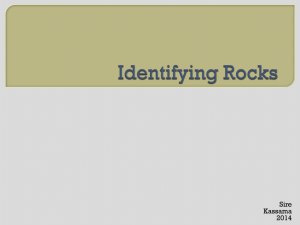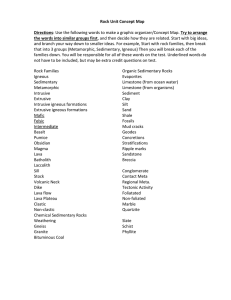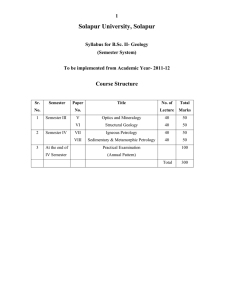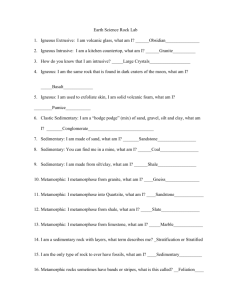Solapur University, Solapur Syllabus for B.Sc. II- Geology Semester System - CGPA
advertisement
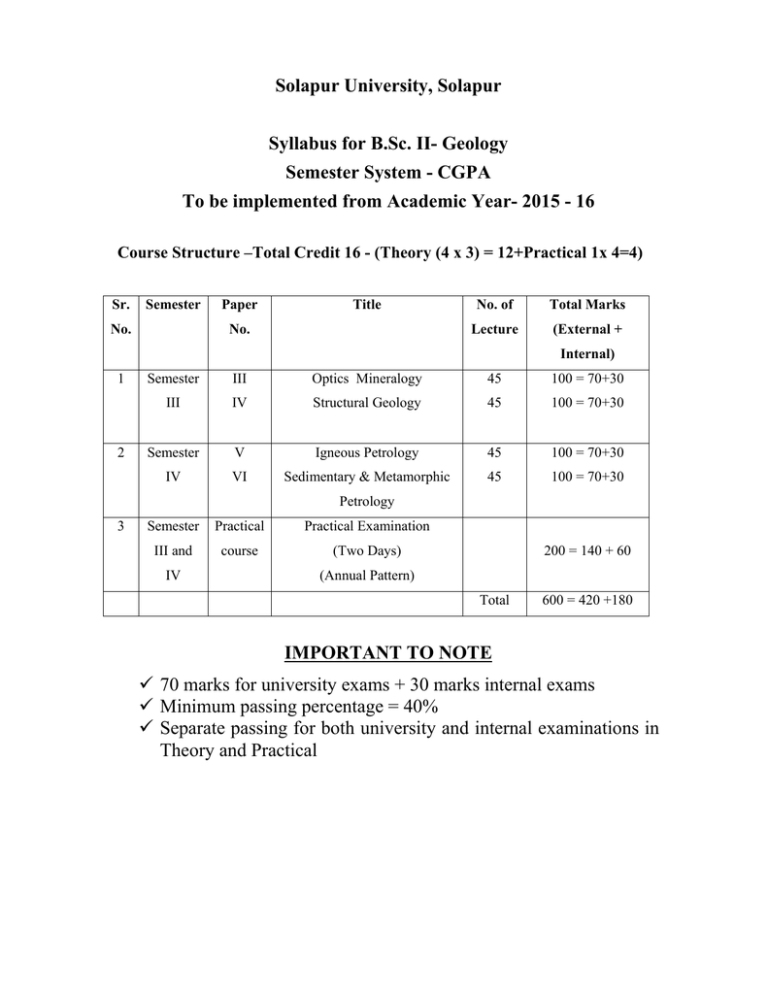
Solapur University, Solapur Syllabus for B.Sc. II- Geology Semester System - CGPA To be implemented from Academic Year- 2015 - 16 Course Structure –Total Credit 16 - (Theory (4 x 3) = 12+Practical 1x 4=4) Sr. Semester No. Paper Title No. No. of Total Marks Lecture (External + Internal) 1 2 Semester III Optics Mineralogy 45 100 = 70+30 III IV Structural Geology 45 100 = 70+30 Semester V Igneous Petrology 45 100 = 70+30 IV VI Sedimentary & Metamorphic 45 100 = 70+30 Petrology 3 Semester Practical Practical Examination III and course (Two Days) IV 200 = 140 + 60 (Annual Pattern) Total 600 = 420 +180 IMPORTANT TO NOTE 9 70 marks for university exams + 30 marks internal exams 9 Minimum passing percentage = 40% 9 Separate passing for both university and internal examinations in Theory and Practical Solapur University, Solapur Syllabus for B.Sc. II- Geology (Theory) Semester System- CGPA SEMESTER – III Paper –III: - Optics Mineralogy. (70 Marks) Credits: 3 (45 periods) Optics: Petrological Microscope. Behaviour of light under petrological microscope. Study of the following optical properties - Colour, form, cleavage, fracture, inclusion, alteration, relief, twinkling, pleochroism, absorption, isotropism, anisotropism, extinction- types of extinction, extinction angle, twinning, zoning, birefringence and interference colours. (20 Periods) Mineralogy: Silicate structures, Isomorphism, Polymorphism, Pseudomorphism. Physical properties, optical properties, mode of occurrence and structure chemistry of the following mineral groups: 1. Olivine- Forsterite, Fayalite 2. Pyroxene – Enstatite, Hypersthene, Diopside, Augite, Jaedite 3. Amphibole – Anthophyllite, Tremolite, Actinolite, Hornblende, Glaucophane 4. Mica – Muscovite, Biotite, Phlogopite, Lepidolite 5. Feldspar - Orthoclase, Microcline, Plagioclase 6. Silica- Minerals with crystalline, crypto- crystalline and amorphous silica 7. Alumino Silicates - Sillimanite, Andalusite, Kyanite 8. Carbonates - Calcite, Aragonite, Magnesite 9. Chlorite - Chlorite 10. Garnet - Common Garnet. 11. Felspathoid – Leucite , Nephelene 12. Clay mineral–Kaolinite (25 periods) Reference Books: 1. Introduction to Rock Forming Minerals - Deer, Howie & Zussman. 2. Optical Mineralogy- Paul Kerr. 3. Rutley's Elements of Mineralogy –H.H. Read. Paper –IV: - Structural Geology. (70 Marks) Credits: 3 (45 Periods) 1. Concept of rock deformation & tectonics. Dip, Strike, Outcrop, width of outcrop, Inliers, outlier, Lineation and foliation (10periods) 2. Fold – Types, nomenclature, Criteria for their recognition in field (10periods) 3. Faults - Classification, recognition in field, effects on outcrops (10periods) 4. Unconformity - Types, recognition in field (7periods) 5. Joints - Types, geometric and genetic classification (8periods) Reference Books: 1. Fundamentals of Structural Geology- N.W. Gokhale 2. Structural Geology - M.P. Billing SEMESTER – IV Paper-V: -- Igneous Petrology. (70 Marks) Credits: 3 (45 periods) 1. Crystallization processes of unicomponent, binary and ternary magma compositions. Formation of glass and crystals (15 periods) 2. Reaction relationships. Textures and Micro-structures (10 periods) 3. Classification of Igneous rocks - based on mode of occurrence, mineralogy, chemistryShand’s and tabular classification (10 periods) 4. Processes of differentiation in magma, assimilation, Xenoliths formation (10 periods) Reference Books: Igneous and metamorphic Petrology - Best M.G Igneous Petrology - Mihir K Bose Igneous and Metamorphic Petrology- Turner Verhoogen Igneous petrology - Anthony Hall Principles of Petrology - G.W. Tyrrell Paper-VI: - Sedimentary & Metamorphic Petrology. Sedimentary Petrology: (70 Marks) Credits: 3 (45 periods) (20 periods) 1. Classification of Sedimentary rocks- based on mineralogical composition, characters of the Sediments (size, shape) (6 periods) 2. Description of sedimentary rock – Rudaceous group, (Conglomerate, Breccia), Arenaceous Group, (sandstones, grit, arkose, greywacke) Argillaceous group (shales, mudstone), Calcareous group (limestones, dolomites) Oxides-Hydroxides group (laterite, bauxite) (8 periods) 3. Processes and environments of sedimentation. (6 periods) Metamorphic Petrology: (25 periods) 1. Brief outline of characters of important metamorphic facies ( Greenschist, Amphibolite, Granulite Eclogite) (6 periods) 2. Fabric of metamorphic rocks (6 periods) 3. Classification of metamorphic rocks based on fabric - strongly foliated, weakly foliated non- foliated. Description of metamorphic rock types- Strongly foliated (slate, phyllite, schists), Weakly foliated (mylonite, gneisses, migmatite), Non foliated (quartzite, marble, skarn, hornfelse, argillite, granulite) (6 periods) 3. Introduction to Retrograde metamorphism, Polymetamorphism, Metasomatism and Anatexis (7periods) Reference Books: Fundamentals of Sedimentary rocks – N.W.Gokhale Igneous and metamorphic Petrology- Best M.G. Igneous and Metamorphic Petrology- Turner Verhoogen Introduction to Sedimentology - Sengupta S Metamorphic petrology - Turner Petrogenesis of Metamorphic Rocks- Winkler H.G.F Petrology of Metamorphic Rocks - Mason Roger Sedimentary Rocks- Petijohn F.J. Syllabus of B Sc. (Part-II) Geology Practical Course (Marks- 140 + 60 = 200) Annual Pattern - CGPA Credits: 4 Practical - I Unit I - Optics and Mineralogy:Optics 1) Study of petrological microscope. i) Study of optical properties of minerals in polarized light ii) Study of optical properties of minerals between crossed nicol prisms. 2) Microscopic study of minerals. 1) Quartz, 2) Orthoclase, 3) Microcline, 4) Plagioclase, 5) Muscovite, 6) Biotite, 7) Hornblende, 8) Actinolite, 9) Tremolite, 10) Augite, 11) Hypersthene, 12) Olivine, 13) Garnet, 14) Staurolite, 15) Calcite, 16) Chlorite 3) Megascopic Study of following minerals. 1) Silica Group-Quartz, Rock Crystal, Amethyst, Chalcedony, Agate, Flint, Jasper, Chert, Opal 2) Feldspar Group- Orthoclase,Microcline,Plagioclase 3) Feldspathoid Group- Nepheline, Leucite, Sodalite 4) Mica Group- Muscovite, Biotite, Lepidolite, Phlogopite 5) Amphibole Group - Hornblende, Actinolite, Tremolite, Asbestos 6) Pyroxene Group - Augite, Diopside, Hypersthene 7) Olivine Group- Olivine 8) Epidote Group- Epidote 9) Chlorite Group – Chlorite 10) Garnet Group- Garnet 11) Alumino-Silicates- Kyanite, alusite, Sillimanite 12) Carbonate Group-Calcite, Dolomite, Magnesite 13) Zeolite Group- Natrolite, Stilbite 14) Apophyllite Group- Apophyliite 15) Corundum, Beryl, Staurolite, Tourmaline, Talc, Serpentine. Unit 2- Structural Geology: 1. Study of geological maps drawing of geological sections of following types A) Horizontal Series B) Inclined series 1) With intrusions - sill, vertical dyke, two intersecting vertical dykes 2) With vertical fault C) An unconformity separating inclined series with horizontal series. 2. Study of structural problems -involving strike, true apparent dips, width of outcrop by graphical method. Practical - II Unit 3 - Petrology 1) Megascopic Study of following rocks: A) Igneous: 1) Granite, 2) Hornblende granite, 3) Graphic granite, 4) Syenite, 5) Diorite, 6) Gabbro, 7) Dunite, 8) Porphyritic granite, 9) Pegmatite, 10) Dolerite, 11) Felsite 12) Rhyolite, 13) Pitchstone, 14) Obsidian, 15) Pumice 16)Trachyte, 17) Basalt B) Sedimentary: 1) Sandstone, 2) Ferruginous sandstone, 3) Grit, 4) Arkose, 5) Breccia, 6) Conglomerate, 7) Limestone, 8) Oolitic limestone, 9) Fossiliferous limestone, 10) Shale, 11) Laterite 12) Bauxite C) Metamorphic: 1) Slate, 2) Phyllites, 3) Mica schist, 4) Marble hornblende Schist, 5) Mica garnet Schist, 6) Mica staurolite schist, 7) Chlorite Schist, 8) Tremolite Schist, 9) Granite Gneiss, 10) Biotite Gneiss, 11) Hornblende Gneiss, 12) Augen Gneiss, 13) Amphibolite, 14) Banded Iron Formation, 15) Charnockite, 16) Marble 17) Quartzite 2) Study of Textures and structures with formation: A) Igneous: 1) Granitic Texture, 2) Porphyritic Texture, 3) Intergrowth, 4) Graphic Texture, 5) Glassy texture, 6) Flow Structure, 7) Vesicular, 8) Amygdaloidal Structure, 9) Ropy Structure, 10) Pillow Structure, 11) Columnar Structure 12) Xenolithic Structure B) Sedimentary: 1) Graded bedding, 2) Current bedding, 3) Lamination, 4) Ripple Marks, 5) Mud cracks, 6) Clastic structure, 7) Oolitic, 8) Pisolitic structure 9) Stractification. C) Metamorphic: 1) Slaty Cleavage, 2) Schistose Structure, 3) Granulose Structure, 4) Gneissose Structure, 5) Augen Structure, 6) Bed Structure 7) Granular / Granoblastic Structure. 3) Microscopic Study of following rocks: A) Igneous: 1) Granite, 2) Hornblende granite, 3) Graphic granite, 4) Syenite, 5) Gabbro, 6) Diorite, 7) Dunite, 8) Basalt, 9) Trachyte 10) Rhyolite. B) Sedimentary: 1) Sstone, 2) Ferruginous Sstone, 3) Arkose, 4) Limestone, 5) Oolitic Limestone 6) Fossiliferous Limestone. C) Metamorphic: 1) Hornblende Schist, 2) Chlorite Schist, 3) Tremolite Schist, 4) Mica Schist, 5) Mica Garnet Schist, 6) Mica Staurolite Schist, 7) Granite Gneiss, 8) Biotite Gneiss, 9) Hornblende Gneiss, 10) Charnockite, 11) Quartzite 12) Marble 4) Study of Textures and Microstructures in Rocks with formation: A) Igneous: 1) Granitic Texture, 2) Ophitic Texture, 3) Porphyritic Texture, 4) lntergrowth, 5) Graphic Texture, 6) Intergranular Texture, 7) Flow Structure, 8) Reaction Rim Structure B) Sedimentary: 1) Clastic Structure, 2) Oolitic & Pisolitic Structure. C) Metamorphic: 1) Slaty Cleavage, 2) Schistose Structure, 3) Granulose Structure, 4) Gneissose Structure, 5) Porphyroblastic. Unit 4 – Study Tour - Field Studies Practical Record 1) Study tour - Field Studies Study tour in the areas of geological interest up to 7 days - long tour or short tours to nearby places to teach the students various rock types their field characters relations. Submission of field report field collection at the time of practical examination is necessary. 2) Practical Record Record of the practical done by the student should be maintained as a journal and map file must be submitted at the time of annual practical examination. -Examination StructureTheory examination 1. The Entire Theory examination will consists of Four Papers Two Papers in Each Semester 2. Each paper of 70 marks - As per University common pattern for Science faculty Time: 3hours __________________________________________________________________________________ --------------------------------------------------------------------------------------------------------------------------th Annual Practical examination at the end of year (4 semester) Practical Examination Practical examination will be conducted annually i.e. at the end of fourth semester only. It will be conducted for total 140 marks Two separate days for Two Practical (Each practical with 70 marks) 1st day – Practical I Total-70 marks 1) Mineralogy Megascopic - (12) Microscopic - (5) 12 10 2) Petrology Megascopic – Igneous Microscopic – Igneous Megascopic – Sedimentary Microscopic – Sedimentary Megascopic – Metamorphic Microscopic – Metamorphic 2nd day- Practical II (5) (2) (5) (2) (5) (2) 10 06 10 06 10 06 Total-70 marks 1) Textures and Structures in rocksMicroscopic- Igneous, Sedimentary, Metamorphic (1 each) Megascopic - Igneous, Sedimentary, Metamorphic (3each) 2) Structural Geology – Geological Map with Section Drawing 3) Structural Problem4) Certified Journal and Map file (10 each) 5) Tour Report with field collection. 09 09 15 07 20 10

